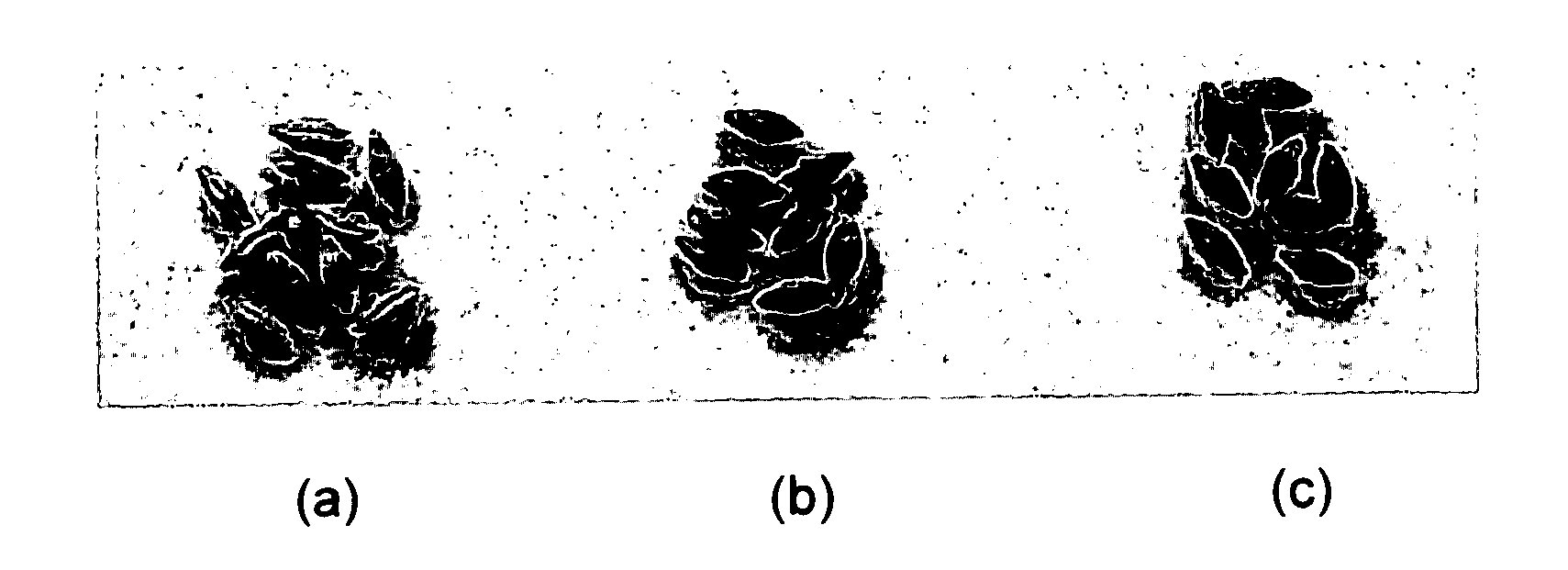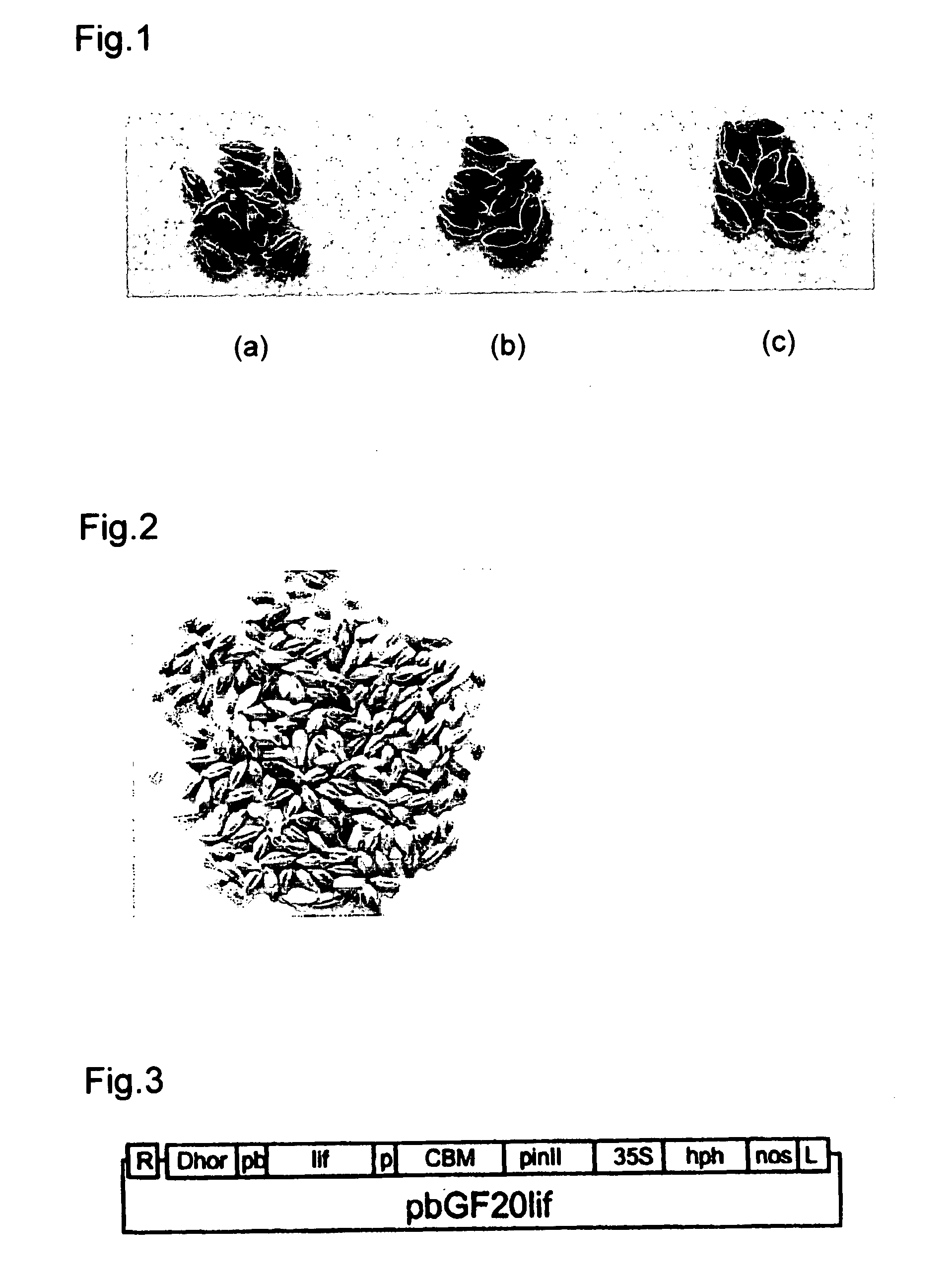Traceability Of Transgenic Plant Seeds In Upstream And Downstream Processing
a transgenic plant and processing technology, applied in the field of plant biotechnology, can solve the problems of inability to distinguish transgenic material from non-transgenic material by simple visual inspection, inability to trace transgenic material, and inability to use simple visual inspection, etc., to achieve economic and reliable effects, reduce the risk of such seed contamination
- Summary
- Abstract
- Description
- Claims
- Application Information
AI Technical Summary
Benefits of technology
Problems solved by technology
Method used
Image
Examples
example 1
[0063] Breeding of Transformable Barley Hybrid Line with Black Seeds
[0064] Seeds from Hordeum vulgaris cv Golden Promise which is amenable for plant transformation and plant regeneration through tissue culture were planted in pots. Sowing was repeated over a few days and plants grown in greenhouse under natural light. At the same time seeds from a Hordeum vulgaris cultivar referred to as “Svarthovdi” that has black seeds but is not amenable for plant transformation and plant regeneration through tissue culture were potted and grown under same conditions. The black seed is a dominant trait of “Svarthofdi” and the phenotype manifested in the seed coat or the aleuron layer of the seed. When the seed is fully mature at least 50% of the seed coat has the black pigmentation. When the flowers on the Golden Promise cultivar were just fully developed, or just after the tillers below the spikes start to emerge from the leaf sheath, ten flowers or spikelet on the spike were opened and the thr...
example 2
[0066] Selection of Barley Hybrid Line with Black Seeds and Amenable for Plant Transformation and Plant Regeneration Through Tissue Culture Using Genetic Transformation
[0067] Immature seeds of 50 hybrid double haploid isogenic lines, about 8 to 14 days post anthesis, were harvested and stored overnight at 4° C. in dark. The cold-incubated immature seed was treated in 70% EtOH for 1 min. and then for 10 min. In 0.6% sodium hypochlorite, followed by thorough washing (5 - 8 times) in sterile distilled water an placed on a sterile Petri plate under dissecting microscope in a laminar flow hood under sterile conditions. The position of the embryo is located, the end of the seed cut off and a scission made down the side of the seed. The seed was held down with forceps and the middle of the seed pressed down so that the embryo was squeezed out. The embryo was held in place with the forceps, scalpel blade inserted in the groove between scutellum and axis and the axis slowly excised. The scu...
example 3
[0068] Production of a Heterologous Protein of Interest
[0069] Seeds from the plant line selected in Example 2 and referred to as Dimma are transformed essentially as described above, except that a gene encoding for a heterologous protein of interest is introduced into the expression vector, instead of the lif-cbm encoding sequence. Successful transformants are sown and grown; seeds are collected and the protein of interest extracted therefrom. It is particularly preferred to express the heterologous protein of interest as a cbm fusion protein, as such fusion proteins can be readily extracted and purified on a large scale and the cbm portion of the fusion protein can optionally be readily cleaved of and separated from the heterologous protein of interest, by introducing a cleaving site recognized by a suitable protease between the cbm encoding sequence and sequence encoding the heterologous protein of interest. Such methods are described in detail in applicant's co-pending applicati...
PUM
| Property | Measurement | Unit |
|---|---|---|
| size | aaaaa | aaaaa |
| pH | aaaaa | aaaaa |
| size | aaaaa | aaaaa |
Abstract
Description
Claims
Application Information
 Login to View More
Login to View More - R&D
- Intellectual Property
- Life Sciences
- Materials
- Tech Scout
- Unparalleled Data Quality
- Higher Quality Content
- 60% Fewer Hallucinations
Browse by: Latest US Patents, China's latest patents, Technical Efficacy Thesaurus, Application Domain, Technology Topic, Popular Technical Reports.
© 2025 PatSnap. All rights reserved.Legal|Privacy policy|Modern Slavery Act Transparency Statement|Sitemap|About US| Contact US: help@patsnap.com


